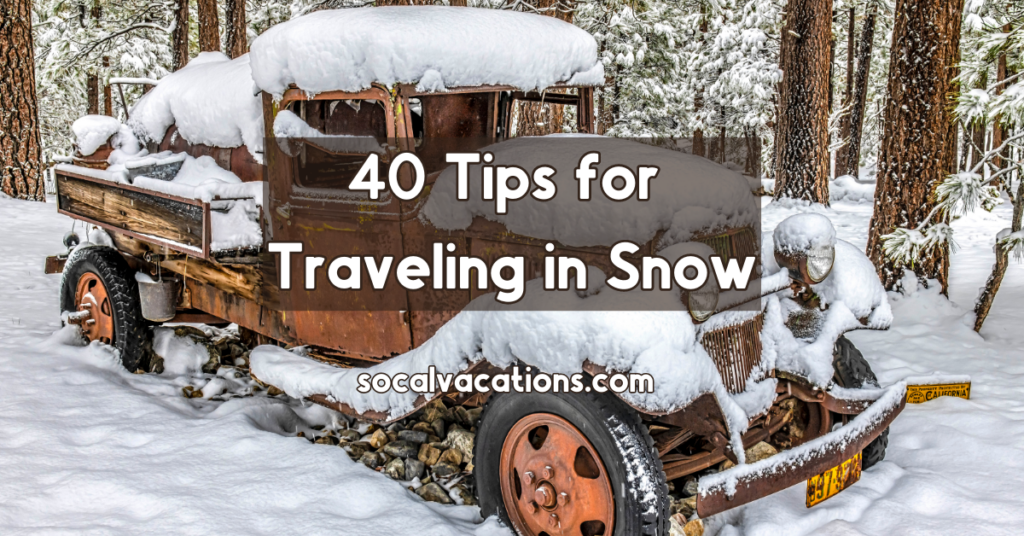Tips for traveling in snow can be extremely helpful, especially for those who live in areas with harsh winters or plan on visiting colder climates. Snow can create hazardous driving conditions, so it’s important to be prepared before hitting the road.
We have put our minds together to bring you 40 tried and proven tips for traveling in the snow… especially when you’re on your way to Big Bear. When traveling in snow, it’s important to be prepared for any situation.
Whether you’re driving a car or RV, or simply walking in snowy weather, following these tips can help keep you safe and comfortable during your travels.
- Always check the weather forecast before heading out. Be aware of any snow storms or blizzards that may be in the forecast.
- Make sure your vehicle is in good condition before heading out. Check the tires for adequate tread depth, brakes, windshield wipers, and fluid levels.
- Carry chains for your tires, as well as traction devices such as sand or kitty litter, in case you get stuck in the snow.
- Pack extra gloves, a warm coat, hats, and blankets in case you get stranded.
- Keep a flashlight and extra batteries on hand in case of power outages or other emergencies.
- Carry extra water and non-perishable food in case you get stranded.
- Make sure your cell phone is fully charged before heading out and consider carrying a portable charger.
- Keep an emergency kit in your vehicle that includes a flashlight, first aid kit, flares, and a small shovel.
- Slow down when driving in snow and leave extra space between you and the vehicle in front of you.
- Keep an eye out for other vehicles that may be having trouble on the road and be prepared to help if needed.
- Use low gear when climbing the mountain and high gear when descending, this allows you to maintain traction and control of the vehicle.
- Always be aware of your surroundings and keep an eye out for potential hazards such as fallen trees, rock slides, and other debris on the road.
- If you do get stranded, stay with your vehicle and call for help. It’s easier for rescue teams to find you if you stay put.
- Always let someone know your travel plans, including your expected arrival time and route. This will allow them to contact authorities if you don’t arrive as expected.
- Drive with your headlights on at all times to increase visibility for yourself and other drivers.
- Avoid using cruise control when driving on snow and ice as it can cause your vehicle to lose traction.
- Avoid sudden movements or sharp turns as this can cause your vehicle to spin out of control.
- Pay attention to road signs and obey all posted speed limits, even if it feels safe to drive faster.
- Avoid overloading your vehicle with too much weight as it can make it more difficult to control in the snow.
- Keep a set of tire chains in your vehicle. Even if you have snow tires, chains can provide extra traction in deep snow. (It’s the law to carry chains in your vehicle from October through April here in the San Bernardino Mountains.)
- If you’re driving a rear-wheel drive vehicle, try to keep more weight in the back of the vehicle to increase traction.
- Make sure your vehicle’s exhaust pipe is clear of snow and ice to prevent carbon monoxide buildup inside the vehicle.
- Avoid using the parking brake in snowy conditions as it can cause your brakes to freeze.
- Always be aware of the road conditions and adjust your driving accordingly. If the road is icy or slippery, slow down and give yourself extra time to react to any hazards.
- Always be ready for the unexpected, and stay calm and focused while driving. Remember that safety should always be your top priority when traveling in the mountains during the winter.
- It’s important to check your vehicle’s battery before heading out in cold weather, as cold temperatures can reduce battery performance.
- Don’t pour hot water onto your windshield to get the ice off as there’s a strong possibility that it’ll crack.
- Be aware of the potential for black ice on the road, which can make the road surface appear to be clear but is actually very slippery.
- If your vehicle starts to skid, turn the steering wheel in the direction you want the front of the car to go.
- Make sure your vehicle’s emergency flashers are working in case you get stranded on the side of the road.
- Consider keeping a full-size shovel in your vehicle to help clear snow from around your tires if you get stuck.
- Consider investing in a set of winter tires, which are specifically designed to provide better traction in snow and ice.
- Always wear your seatbelt when driving in snowy conditions, as it can help protect you in case of an accident.
- Make sure your windshield wipers and fluid are in good working condition to help improve visibility in snowy weather.
- If you’re traveling with children, make sure they are properly secured in car seats or booster seats.
- Remember to keep your gas tank at least half full to prevent the freezing of fuel lines.
- Use turnouts to let cars behind you pass or to put chains on your vehicle, never stop in the middle of the road… and be sure to not park in the turnouts to use them as a sledding area.
- Always be prepared for the worst-case scenario, and bring enough supplies to keep yourself and your passengers warm and safe if you get stranded.
- Remember that even a small amount of snow or ice can make the road surface very slippery, so always drive with caution.
- Stay alert and focused while driving, and avoid distractions such as using your phone or adjusting the radio.
By following these tips and tricks, you’ll be better prepared to travel safely in the mountains during the winter. Remember to always be aware of the weather conditions, check your vehicle before heading out, and pack extra supplies in case of emergency.







